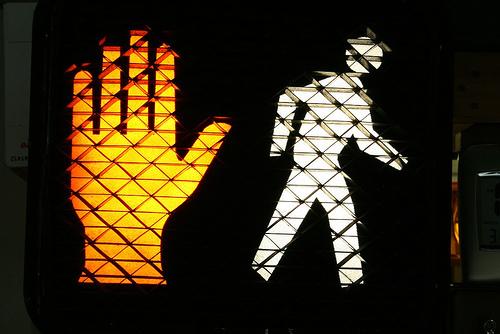Walk signals are bad for walking
To make streets walkable, we need to re-think the basic principles of how people on foot and people in cars share the roadway. This is the third post second in a multi-part opinion series.
Conventional wisdom says that walk signals make crossing the street safer for people. But they actually make walking slower and more dangerous.
Many pedestrians think the walk-don’t walk light helps by letting them know when it’s safe to cross the street. But its actual effect is to curtail the right to make that crossing.
When there’s no walk signal, a green-yellow-red traffic signal sends drivers and pedestrians traveling in the same direction into an intersection during the same green light interval. What the walk signal does is to give traffic engineers the means to send them ahead at different times. In practice, those on foot invariably get less time than drivers — often only the recommended minimum of seven seconds.
Walk signals push pedestrians off the street in more subtle ways, too. Federal Highway Administration rules require new walk signals (except on very narrow streets) to have timers that show how many seconds are left before you must be off the roadway.
But the timer is useless for deciding when to cross. Under the rules, the countdown doesn’t begin until the don’t-walk sign begins to flash — at which point it is illegal to enter the roadway, even if there is enough time to get to the other side. What the timer does is to chase slow walkers back to where they started, supplanting long-established laws that let pedestrians keep going if they’re part way across when the light changes.
One thing pedestrians do like about walk signals is their visibility. But they aren’t needed for this purpose. Red-green lights on streetcorners would be just as visible.
Walk signals are a safety hazard
Not only do the signals make walking slower and less convenient, they make it less safe.
Since — as discussed in the first post of this series — pedestrians are the best judges of their own safety, restricting the right to cross the street is intrinsically dangerous. On top of that, restricting people’s ability to enter the roadway on foot trains drivers not to look out for people walking.
A particular peril is the 7-second crossing interval, which comes just when the drivers’ light turns red. The only time pedestrians are allowed to step into the street is when the cars that waited at the red light (to travel in the direction perpendicular to where the pedestrian wants to walk) begin to turn across their path.
Timers, too, create hazards. They change the behavior of drivers as well as those on foot. Whether the drivers speed up to beat the light or simply get distracted is not clear, but the effect is real. A recent study in Toronto found that countdown timers cause more collisions than they prevent.
Top-down control is the wrong approach
Dutch traffic engineers have found in some villages that removing all traffic signs and markings actually brings accident rates down. It is rarely feasible to go that far on busy American streets, but the underlying principle — that negotiating the use of shared space makes roads safer — still applies.
The philosophy of the walk signal is just the opposite. A central controller sends instructions separately to drivers and pedestrians. One road user doesn’t know what the other is supposed to do — drivers, in particular, are not responsible for looking at walk signals and often can’t see them — so everyone must rely on the controller.
Without shared information, the crosswalk becomes a legal no-man’s-land. Motorists preparing to make turns don’t know whether a person they see on the sidewalk will have the right of way to cross in front of them. When crashes occur, it’s hard to prove the driver is at fault.
If drivers and pedestrians are unable to coordinate, the system operates properly only if each gets correct instructions and follows them reliably. But the reality of the highway is far different. Signals are mistimed, beg buttons (the buttons you sometimes have to push to get a walk signal) don’t work, snow blocks sidewalks, and of course both motorists and pedestrians regularly ignore the law.
The basic flaw of the walk signal is its underlying concept of protecting pedestrians by separating them from vehicles. This leads inevitably to ever-greater restrictions on movement by foot. And it fails to make walking safe.

